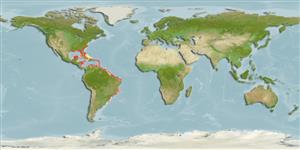Malacostraca |
Decapoda |
Portunidae
Environment: milieu / climate zone / пределы глубины / distribution range
экология
донно-пелагический; пределы глубины 0 - 75 m (ссылка 367). Tropical; 18°C - 31°C (ссылка 367); 38°N - 34°S, 94°W - 32°W
Western Atlantic: USA to Brazil. Tropical to subtropical.
Length at first maturity / Size / Weight / Возраст
половая зрелость: Lm 3.8 range ? - ? cm Max length : 13.0 cm CW самец/пол неопределен; (ссылка 367); 11 cm CW (female); наибольший возраст (опубликованны данные): 2.40 годы (ссылка 85497)
Carapace slightly more than twice as broad as long; 9 teeth on arched anterolateral margin (outer orbital tooth and strong lateral spine included) progressively more acuminate laterally; outer pair of frontal teeth (excluding inner orbital angles) prominent but inner pair small, often almost completely rudimentary. Much of convex dorsal surface lightly granulate, most prominently so on anterior and elevated areas and in transverse lines; central trapezoidal (metagastric) area short and wide (anterior width about 2.8 times, posterior width about 1.75 times length). Pincers dissimilar, ridged longitudinally; fifth legs flattened in form of paddles. Male with T-shaped abdomen reaching slightly beyond suture between thoracic sternites 4 and 5, usually with distal parts recessed below plane of sternum in retracted position. First pleopods overlapping proximally, nearly straight distally, terminating in usually lanceolate membranous tip near level of suture between thoracic sternites 6 and 7, armed subterminally with short retrogressive spinules. Color: variable. Light greyish green, olive, pinkish, or brown, spines maroon to blue or white, white-tipped; pincers with outer face white, inner surface dark blue; varying transverse light-dark bands on paddles, other legs tinted blue; underparts whitish to grey.
Minimum carapace width: 0.94 cm (Ref. 93549). Minimum depth from Ref. 101595. Occurs from the intertidal zone to 75 m (Ref. 106798). Inhabits sandy or muddy bottoms, or shell and sponge covered bottoms (young crabs). Tolerates a broad range of salinities from 0 to 50 ppm and temperatures of 18 to 31°C. May be seen in bays or river mouths or even in freshwaters, but is abundant in waters of relatively high salinities. Feeds on mollusks, other bottom invertebrates, fishes, carrion and detritus. Albinistic individuals occur where substrates are light colored (Ref. 367).
Life cycle and mating behavior
половая зрелость | размножение | нерест | Eggs | Fecundity | Larvae
Members of the order Decapoda are mostly gonochoric. Mating behavior: Precopulatory courtship ritual is common (through olfactory and tactile cues); usually indirect sperm transfer.
Основная ссылка
ссылки | координатор | соавторы
Melo, G.A.M. 1996 Manual de identifição dos Brachyura (Caranguejos e Siris) do littoral brasileiro. Editora Plêiade FAPSES 604 p. (ссылка 8729)
Статус Красного Списка МСОП
(ссылка 130435: Version 2025-1)
Статус СИТЕС (ссылка 108899)
Not Evaluated
CMS (ссылка 116361)
Not Evaluated
Угроза для людей
Использование человеком
рыболовство: коммерческий
| FishSource |
инструменты
дополнительная информация
PhysiologyOxygen consumption
Human RelatedStamps, coins, misc.
ресурсы в Интернет
Estimates based on models
Preferred temperature
(Ref.
115969): 22.6 - 28, mean 25.7 (based on 456 cells).
устойчивость к внешним воздействиям
высокий, минимальное время удвоения популяции до 15 месяцев (K=1.83; tmax=2.4).
Fishing Vulnerability
Low vulnerability (10 of 100).
